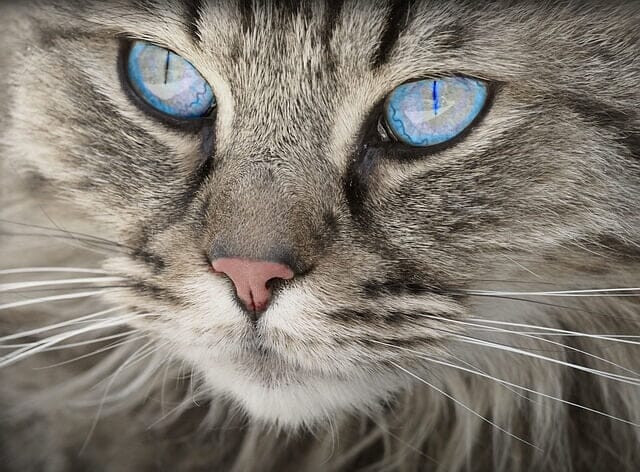Did you know that a blind cat is equipped to be able to navigate a room well due to the amazing functions of whiskers? Whiskers, scientifically known as vibrissae, are specialized sensory hairs found on the faces, cheeks, and wrists of cats. These seemingly simple structures are crucial in a cat's life, helping them navigate their environment with astonishing precision. There are several different types and functions of cat whiskers.
Table of Contents
Why are Whiskers Important to Cats?
Whiskers are more than mere hairs; they are highly specialized sensory organs, serving as extensions of a cat's nervous system. They are integral to a cat's ability to perceive and respond to its surroundings effectively. Whiskers are finely attuned to touch and vibrations and transmit sensory and navigational information to a cat's brain. Whiskers are highly sensitive to touch and vibrations. They act as extensions of a cat's nervous system, providing them with valuable information about their environment.
By detecting even subtle changes in air currents, vibrations, and movements, whiskers help cats navigate and explore their surroundings more effectively. Cats utilize their whiskers to gather essential information about their surroundings, detect potential threats, and even communicate with other cats. Their whiskers are like finely tuned antennae, granting them access to an intricate world of sensory input. Whiskers are important to cats as they serve several important functions and play a vital role in a cat's overall sensory perception and navigation, including:
Estimating Space and Size
Communicating Emotions
Hunting and Prey Detection
Protective Mechanism
Sensing the Surroundings
The Different Types of Cat Whiskers and Their Functions
Cats possess various types of whiskers, each with a distinct role. Understanding these types and functions is key to comprehending how cats navigate their world through whisker watches. Whiskers are more than mere hairs; they are highly specialized sensory organs, that are finely attuned to touch and vibrations and transmit sensory information to a cat's brain. Cats have several types of whiskers, each serving a specific function. Here are the different types of cat whiskers and their functions:
1. Mystacial Whiskers
Mystacial whiskers are the most prominent and well-known type of whiskers. They are located on either side of a cat's muzzle, arranged in horizontal rows. Mystacial whiskers are longer and stiffer than other types of whiskers. They serve multiple functions, including:
- Navigation and Sensory Perception: Mystacial whiskers help cats navigate their environment and sense their surroundings. They can detect subtle changes in air currents, allowing cats to identify the presence of objects, obstacles, or prey in their vicinity.
- Estimation of Space and Size: Mystacial whiskers assist cats in determining whether they can fit through narrow spaces or gaps without getting stuck. By extending their whiskers, cats can measure the width of openings and make accurate judgments about their ability to pass through.
- Facial Expression and Communication: Mystacial whiskers can also indicate a cat's emotional state or intentions. When a cat is calm and relaxed, their whiskers are typically in a neutral or slightly forward position. However, if a cat feels threatened or agitated, their whiskers may become more erect or pulled back, signaling a defensive or aggressive stance.
2. Superciliary Whiskers
Superciliary whiskers, also known as eyebrow whiskers, are located above a cat's eyes. They are shorter and more flexible than mystacial whiskers and their functions include:
- Protection: Superciliary whiskers help protect a cat's eyes from potential hazards. They act as a warning system by detecting any objects or obstacles that might come into contact with the cat's face, helping to prevent injury to the eyes.
- Sensory Perception: Similar to mystacial whiskers, superciliary whiskers assist in detecting changes in air currents, providing additional sensory information about the environment.
3. Genal Whiskers
Genal whiskers are found on the cheeks of a cat, extending from the outer edges of the eyes to the sides of the muzzle. They are shorter and softer than mystacial whiskers. The functions of genal whiskers include:
- Sensory Perception: Genal whiskers contribute to a cat's sensory perception by providing additional input about their immediate surroundings.
- Social Interaction: Cats often use their genal whiskers during social interactions, such as greeting or rubbing against other cats or humans. The gentle touch of these whiskers can convey affection and establish social bonds.
4. Leg Whiskers
Cats also have whiskers on the backs of their front legs, known as carpal whiskers. Cats do not see as well up close and these whiskers act as another set of eyes to help kitty sense the movement of prey up at a short distance, or in their clutches.
- Navigation and Sensory Perception: Carpal whiskers help cats to climb trees and kill prey.
- Hunting: Carpal whiskers can pick up subtle movements and vibrations made by potential prey, allowing cats to accurately judge the position and movement of their catch. The carpal whiskers tell the cat if there is any movement of the caught prey in their paws. Overall, whiskers are crucial sensory tools for cats, helping them navigate, communicate, and perceive their environment with precision and accuracy.
Whiskers Can Detect Different Types of Information
Discover the range of sensory input that whiskers provide to cats, including detecting changes in air currents, temperature, texture, and vibrations. Here are the different types of information that whiskers can detect:
Air Currents and Wind Direction:
Whiskers are highly sensitive to changes in air currents. They can detect even subtle movements of air, allowing cats to determine the direction and speed of the wind. This information is valuable for cats when hunting, navigating, or perceiving the presence of objects or other animals in their surroundings.
Objects and Obstacles:
Whiskers help cats detect the presence of objects and obstacles in their immediate environment. By extending their whiskers forward, cats can determine if they are approaching a solid surface, such as a wall or furniture. Whiskers can prevent cats from colliding with objects or getting stuck in narrow spaces.
Size and Shape of Objects:
Whiskers provide cats with information about the size and shape of nearby objects. As cats move their whiskers along the contours of an object, they can assess its dimensions and determine if it poses any potential threat or interest.
Changes in Terrain:
Cats use their whiskers to gauge changes in terrain or surfaces they walk on. The slight variations in vibration or texture that the whiskers pick up can help cats navigate uneven surfaces, such as stairs or rocky terrain, and adjust their movements accordingly.
Water:
Whiskers can also provide cats with information about the presence of water. When a cat's whiskers come into contact with the surface of water, they can detect slight changes in water movement and determine its depth or proximity. Whiskers serve as an extension of a cat's tactile sense, enabling them to gather valuable information about their environment.
By interpreting the sensory input from their whiskers, cats can navigate, hunt, and interact with their surroundings more effectively. It is important to respect a cat's whiskers and avoid trimming or cutting them, as it can disrupt their ability to perceive and interpret their environment accurately.
How to Take Care of Your Cat's Whiskers
1. Do not Trim or Cut Your Cat's Whiskers
Understanding the importance of whiskers means never attempting to trim or cut them. Learn why this is crucial for your cat's well-being.
2. Provide Your Cat With a Clean and Safe Environment
Having an environment that respects and protects your cat's whiskers is important.
3. Be Aware of Any Changes in Your Cat's Whisker Behavior
Cats use their whiskers to communicate with you, too. Be attentive to any changes in their whisker behavior, as it can be an indicator of health or emotional issues. For cats that tend to be more nervous or skittish, our Pet Relax Anxiety and Stress Relief is a wonderful natural aid to help them be naturally calm.
4. Buy Right Size Bowl for Feeding
Cat whiskers are highly sensitive, and if obstructed, they can hinder a cat's ability to eat. When selecting a bowl for your cat, make sure it has a diameter that is not too small, allowing them to enjoy their meal without their whiskers being bothered. We also discuss this in the blog, Are You Making These Common Mistakes With Your Cat?
Conclusion
Whiskers are not just hairs; they are the unsung heroes of a cat's world. They allow cats to move gracefully through their environment, hunt with precision, and communicate with finesse. Understanding the pivotal role whiskers play in a cat's life is the first step in appreciating the incredible creatures that share our homes. Take a moment to marvel at your cat's whiskers, those elegant, finely tuned sensory organs that enhance their lives in myriad ways. Recognize the significance of those whiskers in maintaining their well-being and happiness. Lastly, as you share your life with a whiskered companion, ensure that their environment respects and protects their precious whiskers. Your awareness of their importance will contribute to a harmonious and fulfilling life together.



